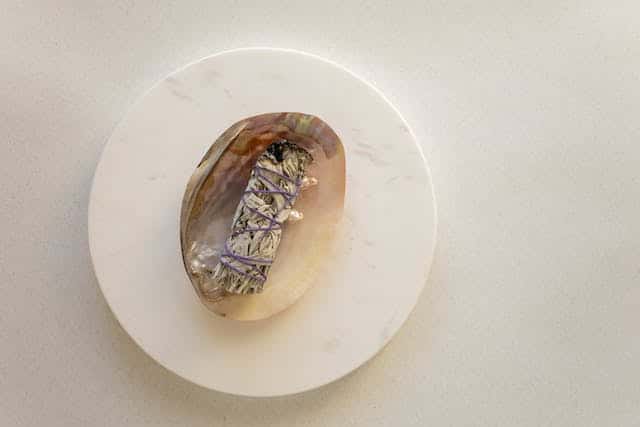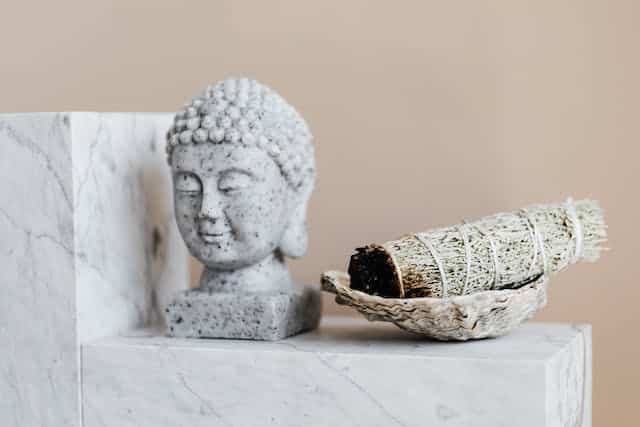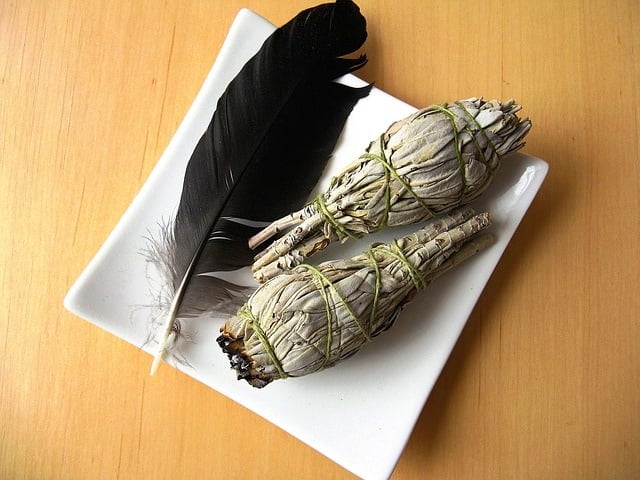
This guide delves into the profound essence of smudged sage, offering a detailed pathway to harnessing its purifying properties for your living space.
Understanding Smudged Sage

Smudged sage, often characterised by its distinct, earthy fragrance, is far more than an ordinary herb. This sacred plant is revered for its purifying properties, playing a pivotal role in rituals designed to cleanse spaces of negative energy.
Burning sage, smudging or sage cleansing, is deeply rooted in the traditions of many Indigenous cultures, where it’s famous not only for its spiritual significance but also for its ability to promote healing and wisdom.
Among the varieties of sage suitable for smudging, white sage is particularly esteemed. This variety is often preferred for its strong aromatic properties, which are released upon burning.
The smoke from a white sage smudge stick is traditionally used to purify the surroundings, creating a space that’s conducive to healing and meditation. The act of burning this sacred herb is seen as a way to bridge the earthly with the spiritual, clearing the air of more than just physical impurities.
The process of burning sage to cleanse your and self of negativity, it involves lighting the end of a smudge stick and allowing it to smoulder. The resulting smoke is then directed around the space or over a person, with a specific focus on areas believed to harbour stagnant or negative energy. This practice is often accompanied by specific prayers or intentions, setting the stage for a spiritual cleansing.
While the practice of burning herbs for purification is not unique to any one culture, the use of smudged sage, particularly white sage smudge sticks, has gained widespread recognition.
However, it’s crucial to approach this practice with respect and understanding, acknowledging its deep cultural roots and spiritual significance. The burning of sage is more than a mere ritual; it’s a profound act of cleansing and renewal, esteemed for its ability to clear negative energy and promote a sense of peace and clarity.
In adopting the practice of burning sage, it’s essential to do so with mindfulness and respect, ensuring the sustainability of this precious herb and honouring the traditions from which this practice originates.
By understanding the significance of smudged sage, individuals can engage in this ancient practice thoughtfully, contributing to a respectful continuation of its cultural and spiritual legacy.
Preparing for a Smudging Ceremony

Engaging in a smudging ceremony is a practice steeped in tradition and reverence. It’s a process that requires careful preparation and a respectful mindset. The act of burning sage, particularly within a smudge stick, is central to this ritual. The preparation stage is as crucial as the ceremony itself, involving the thoughtful selection of materials and setting of intentions.
Firstly, selecting the right type of sage is paramount. Sage bundles come in various forms, each with its unique properties and uses. When preparing to burn sage, it’s advisable to opt for a sage bundle that resonates with the purpose of your smudging ceremony. Many choose white sage for its strong, purifying smoke and its traditional significance in cleansing ceremonies.
Once you have your sage bundle ready, gathering the rest of your smudging tools is the next step. An abalone shell is commonly used to hold the burning sage safely, capturing any falling ashes and embodying the element of water, bringing balance to the fiery aspect of the burning sage. Additionally, a feather is often used to fan and direct the smoke, ensuring that the sage burning ritual encompasses all areas that require purification.
The process of sage burning is not just about the physical act; it’s equally about your mindset and intentions. Before you begin to burn sage, take a moment to reflect on your intentions for the smudging ceremony. Are you looking to cleanse your space of negative energy, or are you seeking to bless a new home or an object? Setting clear, positive intentions is a fundamental part of the ceremony, aligning your thoughts and energy with the physical actions of the ritual.
Preparing your space is also essential. Ensure that the area is well-ventilated; burning sage produces smoke that should be able to escape, especially in a closed environment. As you prepare to light your smudge stick, respect the sacred nature of the ritual. Approach the process with a sense of reverence, understanding that burning sage is a practice rooted in deep cultural traditions.
Finally, as you prepare to burn sage, remember that this is a practice rich in heritage and significance. It’s not just a physical cleansing but also a spiritual one, aiming to harmonise your space and your spirit. With your sage bundle, smudge stick, and other tools at the ready, along with a clear and respectful intention, you are set to carry out your smudging ceremony, honouring the ancient tradition of sage burning.
The Smudging Process

The smudging process is a profound practice, weaving together the art of mindful presence with the depth of ancient spiritual rituals. It’s a practice deeply respected in Native American cultures, which is seen as a bridge between the earthly and the spiritual realms.
This sacred ritual involves the burning of sage, often California white sage, known for its strong, purifying properties.
To begin the smudging process, it’s essential to approach the ritual with a sense of reverence and respect, acknowledging its roots as an ancient spiritual ritual. Start by lighting the sage bundle.
Once lit, gently blow out the flame, allowing the sage to smoulder and produce a cleansing smoke. This smoke is the central element in the smudging process, carrying away the impurities and negative energies that may be dwelling in your space.
As the sage begins to smoulder, carry it carefully through your home. Pay special attention to the corners, doorways, and window areas – spaces that are often thought to accumulate stagnant energy.
As you guide the smoke into these spaces, do so with a deliberate and mindful presence, ensuring that the smoke reaches every part of the area you wish to cleanse.
While the sage does its work, it’s common and beneficial to accompany the physical action with recitations of prayers or affirmations. These spoken words amplify the intention behind the smudging, aligning your thoughts and energy with the purifying smoke.
This combination of physical and spiritual action creates a powerful synergy, enhancing the efficacy of the cleansing process.
In Native American cultures, and in many others that respect the practice, the smudging process is more than just a cleansing ritual; it’s a sacred moment, a time for healing and reconnecting with the spiritual realm.
The use of California white sage, with its strong, aromatic properties, is particularly valued in these rituals, serving as a powerful tool in the journey towards purification and peace.
Safety Considerations and Best Practices

Engaging in the traditional practice of smudging involves not only a spiritual commitment but also a conscientious approach to safety and ethical considerations.
The burning of sage, especially within the confines of indoor spaces, requires a mindful adherence to certain precautions to ensure the well-being of all participants and the environment.
First and foremost, when the sage is lit and the sage smoke begins to rise, it’s imperative to place the smouldering sage on a heat-resistant surface.
An abalone shell is commonly used in cleansing rituals not only for its ability to withstand heat but also for its symbolic representation of water, creating a balance with the fire element of the burning sage.
This practice prevents the risk of fire and ensures that the ashes are contained in a safe and controlled manner.
Ventilation is another key aspect of safety during smudging. As the sage smoke permeates the space, cleansing and purifying the environment, it’s important to allow for a proper flow of air.
Open windows or doors to ensure that the smoke, along with the negative energies it’s believed to carry, can be released into the ether, leaving your space cleansed and rejuvenated.
Adequate ventilation also ensures the comfort and safety of all participants, preventing any discomfort from smoke inhalation.
In addition to these safety practices, the sourcing of your sage is a matter of both ethical and spiritual importance. The traditional practice of smudging is deeply rooted in Indigenous cultures, where the use of sage and other herbs in cleansing rituals is considered sacred.
Honouring this tradition involves not only using sage with respect during the ritual but also ensuring that the sage itself is sourced responsibly. Opt for suppliers who harvest sage sustainably, respecting the earth and the cultural significance of the plant.
This approach ensures that the sacred practice can continue without depleting the natural resources and honours the cultural heritage from which this practice originates.
After the Smudging Ceremony

The conclusion of a smudging ceremony is as significant as its commencement and execution. It’s a time to reflect, absorb the tranquillity, and ensure that the practice is closed with the same reverence with which it was opened.
Properly concluding the ceremony is not only a matter of respect for the tradition but also a step to ensure safety and maintain the serene atmosphere achieved through smudging.
Once the cleansing is complete, it’s crucial to ensure that the sage is entirely extinguished. This can be done by snuffing out the smudge stick in the sand or pressing it against a heat-resistant surface until no more embers are glowing.
This step is vital to prevent any unintended fire hazards and to mark the ceremonial end of the sage burning.
A respectful practice following the smudging ceremony is to bury the remaining ashes. This act is seen as returning what has been used back to the earth, signifying the completion of the purification process.
This practice aligns with many Indigenous traditions and is a gesture of gratitude to the earth for the sage it has provided.
Post-smudging, individuals often report feeling a sense of calm and clarity in their space. The atmosphere feels lighter, and the energy purer. These subtle yet profound changes are part of the beauty of smudging.
To maintain this renewed sense of tranquillity, regular smudging can be integrated into your routine, aligning the practice with your personal needs and intuition.
However, it’s paramount to approach regular smudging with an understanding of cultural appropriation. The sacred practice of smudging is deeply rooted in the traditions of Indigenous people, and its commercialization by mass-market retailers has raised concerns.
It’s essential to engage in smudging with respect for its cultural origins, ensuring that the practice doesn’t strip away its spiritual significance or exploit the cultural heritage it belongs to.
Conclusion
Smudging with sage is more than a ritual; it’s a journey of reconnecting with ancient wisdom, embracing tranquility, and cultivating a sacred space in our often chaotic world.
As you incorporate this time-honored practice into your routine, may it bring peace and purity into your home and heart.

